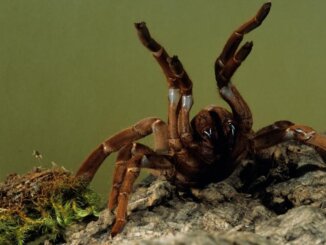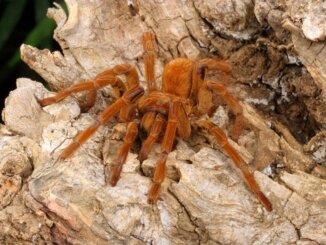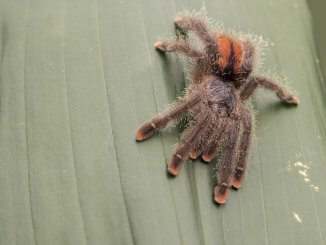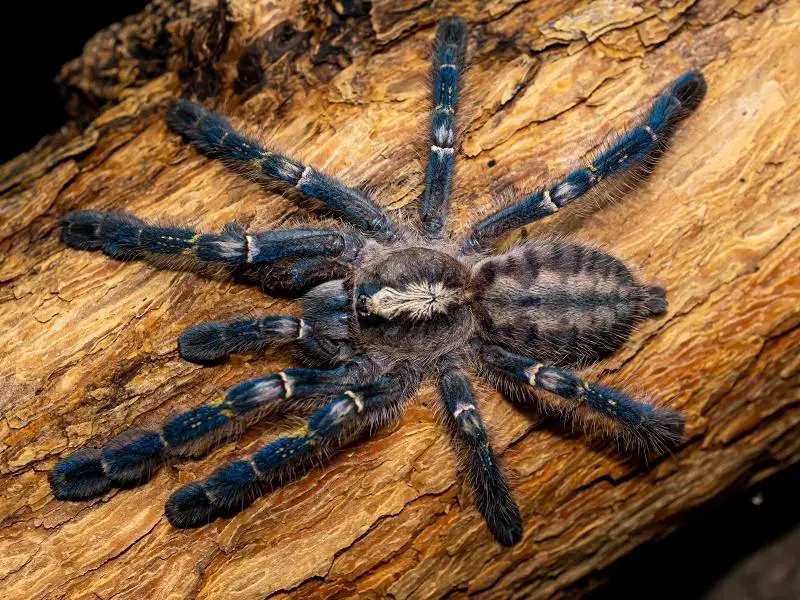
The Poecilotheria metallica is an old-world tarantula species of the genus Poecilotheria, hailing from Southeast India. The spider has a leg span measuring 6 to 8 inches and a hairy body with a metallic blue hue.
Poecilotheria metallicas are hardy and moderately easy to care for. However, the tarantulas’ bites cause intense pain and swelling, so these spiders are not recommended for handling by beginners.
Poecilotheria Metallica Overview
| Common name | Poecilotheria metallica, Gooty sapphire ornamental tree spider, Gooty tarantula, metallic tarantula, peacock tarantula, peacock parachute spider |
| Scientific name | Poecilotheria metallica |
| Natural habitat | Warm, humid deciduous forests in Southeast India |
| Adult size | 6–8 inches |
| Average lifespan | Females: 11–12 years Males: 3–4 years |
| Diet | Carnivore |
| Housing | Minimum 10 gallons, 64–74°F, 75%–85% humidity |
| Experience | Intermediate |
Origin
The Poecilotheria metallica originates in deciduous forests in Southeast India. The tarantula’s natural habitat is warm, humid, and tropical. This tarantula is an arboreal (tree-climbing) species that lives in tall trees and makes funnel webs to catch flying insects. P. metallicas are found in a small area of less than 100 square kilometers that’s rapidly degrading due to firewood harvesting. The spiders have been classified as critically endangered by the IUCN.
Appearance and Behavior
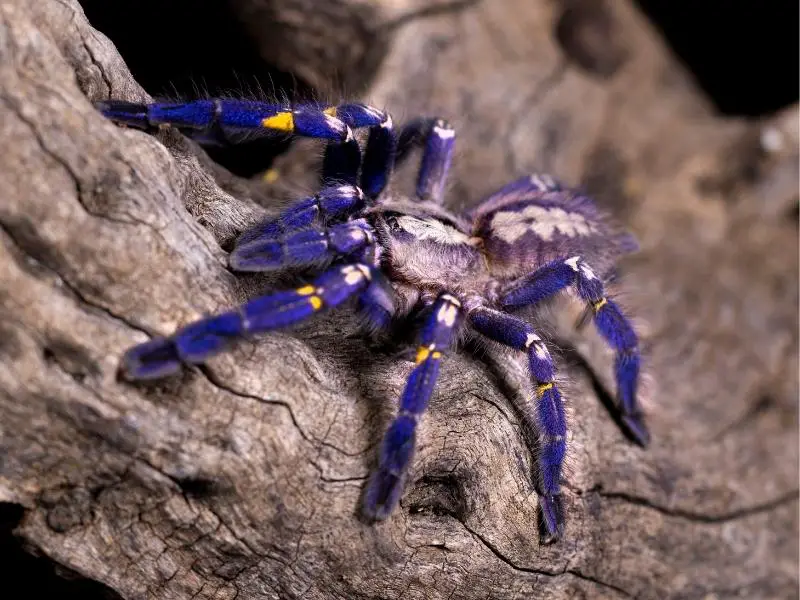
The Poecilotheria metallica is a hairy tarantula with a blue-hued body and legs, and hints of white, yellow, and black coloration. Males are more vibrantly colored than females, especially during mating season. Spiderlings have a faded blue color that becomes bolder as the spiders grow.
Size and Lifespan
The average adult size of P. metallica is 6 to 8 inches. Male and female spiders are the same size.
Females live for 11 to 12 years or up to 15 years with exceptional care in captivity. Males live for three to four years on average.
Temperament
P.metallicas are reclusive and skittish and are known for their unpredictable behaviors. The tarantulas are known to live together in the wild when the territory is limited, but they prefer their own space and may fight if housed together in captivity.
The P. metallica is easily stressed by handling or any action that could be perceived as a danger, such as sudden movement in the spider’s environment. The spider is also photosensitive (sensitive to light), and is most active during the night.
Gooty tarantulas are more likely to run away than attack, but they’re known for their intensely painful bite, so they shouldn’t be handled unless absolutely necessary.
Housing Poecilotheria Metallicas
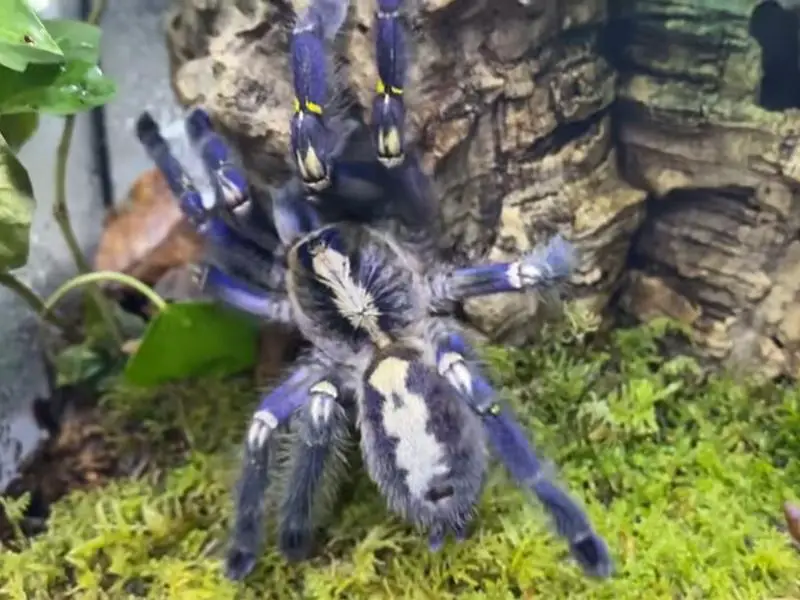
The Poecilotheria metallica’s natural habitats in the wild are tropical forests. Replicate the spider’s habitat in the tank to ensure the spider feels at home in captivity.
The best type of enclosure for a P. metallica is a glass terrarium.
Enclosure size
The enclosure for a single full-sized adult Gooty tarantula should be around 10 gallons. P. metallicas are arboreal spiders that climb and live in trees in the wild, so the enclosure should have extra height. An enclosure that measures 18 x 18 inches and 24 inches high is ideal for this tarantula species.
Lighting
The Gooty tarantula doesn’t require special UVB lighting. Due to the spider’s photosensitivity, additional tank lighting should be avoided. Place the enclosure in a dimly lit room that doesn’t receive full sunlight. If you add a heat lamp to the enclosure, choose a lamp that doesn’t emit light.
Temperature and Humidity
P. metallicas are used to warm, humid conditions. Match the climate of the tarantula’s natural habitat by maintaining an enclosure temperature of 64 to 74°F and a humidity of 75% to 85%. A gentle heat lamp can be used to provide a consistent source of heat in the enclosure. Monitor the enclosure’s temperature with a thermometer.
To maintain humidity levels, place a bowl of water in the middle of the enclosure and mist the substrate with water if the humidity begins to drop.
A humid enclosure keeps the spider hydrated so it can molt. The tank should be well-ventilated to prevent excessive humidity, which may cause fungal infections and suffocation. Humidity levels can be monitored with a hygrometer.
Substrate and Decoration
Ideal substrate for a P. metallica enclosure is peat moss mixed with coconut fiber and eco earth. Add about 2 inches of the substrate to the bottom of the tank — P. metallicas spend most of their time in trees and don’t like to dig, so 2 inches of the substrate is plenty.
Use sticks, fake plants, and cork bark tubes to construct a vertical environment in the enclosure, providing plenty of above-ground spaces for the spider to sleep and hide in. Place a shallow water bowl at the bottom of the enclosure. Line the underside of the enclosure lid with artificial foliage to mimic the canopy of trees in the tarantula’s wild habitat.
Cleaning
To maintain a clean, hygienic living environment for your P. metallica, spot-clean the enclosure once a week and do a thorough clean once every six months.
To spot clean the enclosure, remove unwanted food, molted exoskeletons, and dirty substrate, and add a fresh layer of the substrate to the bottom of the tank. Wash out and refill the water bowl. Gooty tarantulas are clean spiders, so spot-cleaning should be a quick, easy task.
To deep-clean the enclosure, put on a pair of protective gloves and carefully transfer the spider to a temporary enclosure. Remove all the substrate and decorations from the home enclosure and wipe down the surfaces with a cloth dipped in soapy water. Soak the decorations in soapy water. Dry the enclosure and decorations, then return the decorations to the enclosure and add a fresh layer of the substrate. Return the spider to the home enclosure as quickly as possible to minimize stress.
Poecilotheria Metallica Care
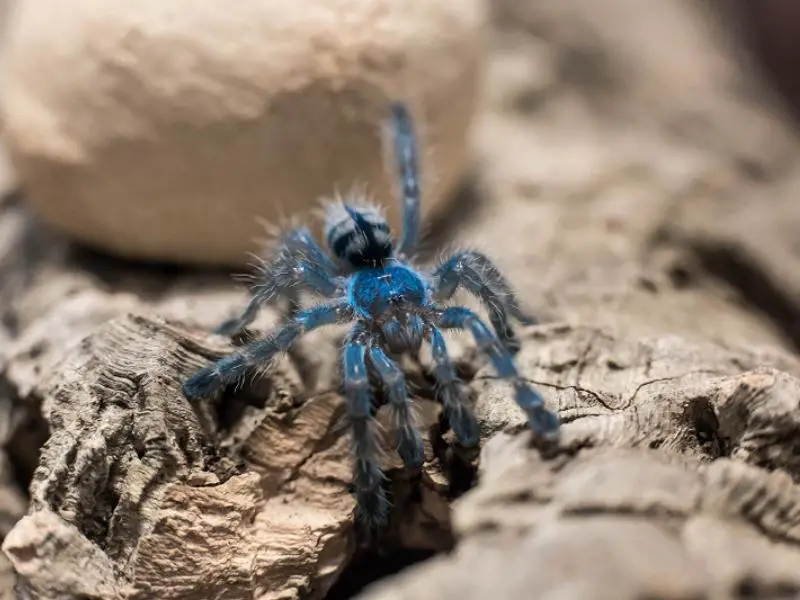
Caring for a Poecilotheria metallica is moderately difficult. The spider is hardy and easy to feed, but handling P. metallica is risky due to the spider’s unpredictable nature.
Food and Water
Feed an adult P. metallica two or three crickets, and the occasional Dubai roach or mealworm, once a week. Spiderlings should eat flightless fruit flies until their leg spans reach half an inch.
Feed your tarantula in the evening to mimic the P. metallica’s wild, nighttime feeding habits. Leave a bowl of fresh water in the tank for the tarantula to drink from throughout the day.
Handling
P. metallicas are shy, skittish tarantulas that don’t enjoy being handled. The spiders will attempt to escape if they sense danger — and if escaping isn’t an option, they may bite to defend themselves. A P. metallica’s bite is considered medically significant, and the spider’s venom causes intense pain. Only handle the spider when absolutely necessary (such as for medical examinations or to relocate the spider to a new tank), and wear thick, protective gloves during handling.
Common Health Issues
Tarantulas in captivity aren’t prone to many common health issues. P. metallicas are hardy spiders, but they may become stressed by cramped tank conditions and overexposure to light. Reduce the risk of stress by providing plenty of climbing space and a dimly-lit environment for your tarantula.
Aside from stress, several health concerns that are known to affect P. metallicas are:
- Dehydration: Caused by a lack of water or food and low humidity levels in the enclosure. Symptoms include a shriveled abdomen and an inability to lift the body off the ground. Increase enclosure humidity to optimal levels and provide a bowl of water to remedy dehydration
- Mites: Passed on from contaminated foods or tank decorations. Mites in an enclosure are harmless, but hundreds or thousands of mites could swarm the spider’s mouth parts or book lungs. Reduce mites by placing a piece of rotting fruit in the enclosure, then remove the fruit when it has been swarmed by mites. Repeat until most mites are removed
- Injuries: Caused by poor molting, bad handling, or a fall. Mend a wound with superglue as soon as you notice it to prevent hemolymph (the spider’s blood) from escaping. Take the spider to an emergency veterinarian for further assessment
Breeding
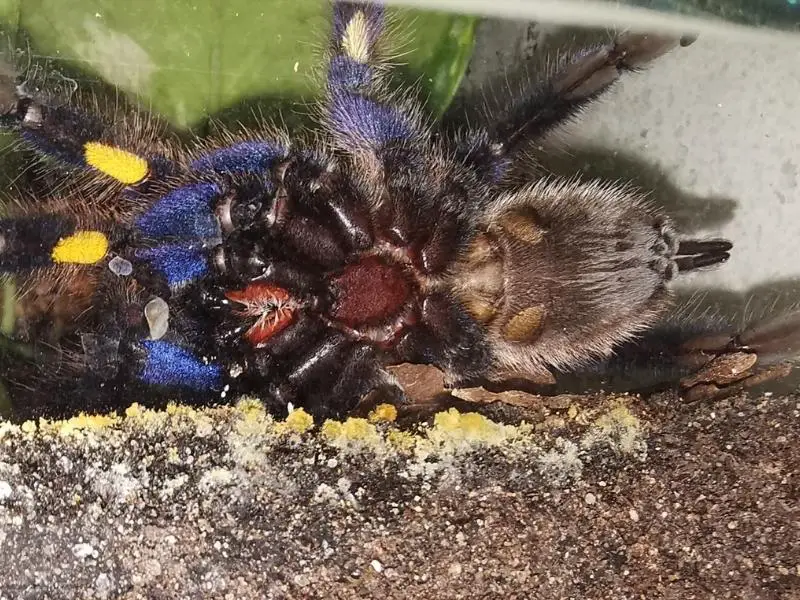
Breeding the Poecilotheria metallica is relatively easy, but should only be attempted by professional breeders due to the risk of fighting between the male and female. The P. metallica reaches sexual maturity at 18 to 24 months old.
To breed P. metallicas, match a male with a female four to six weeks after her last molt, and follow these steps:
- Set up a separate warm, dark breeding tank with plenty of hiding spaces for the male
- Feed the female one week before moving her to the breeding tank to reduce the risk of aggressive behavior
- Place the male and female in the breeding tank one week after feeding the female and watch their behaviors carefully. If the female lunges at the male, remove the male and wait several days before trying again with the same spiders
- Wait for mating to occur. If the female is interested in the male, the male will copulate with her and then retreat to avoid being eaten by the female. Remove the male after breeding has occurred
- Wait for four to six months for the female to make a cocoon and lay her eggs
- Store the eggs at a temperature of 77 to 84°F and a humidity of 80% to 90% for two to three weeks, until they hatch
- Keep the spiderlings in a group and feed them flightless fruit flies. Mist the tank or provide a shallow bowl of water to keep the spiderlings hydrated
- Move the spiderlings to their own enclosures once the tarantulas claim their own territories and when you notice a difference in size between the spiderlings
Choosing and Buying a Poecilotheria Metallica
A Poecilotheria metallica costs between $100 and $200. Females are more expensive than males because they live for up to four times as long as males.
This tarantula species is easy to breed and commonly available from breeders. Due to their endangered status, wild-caught P. metallicas are rarely available.
Buy the spider from a reputable breeder who can provide essential information on how to raise and care for it. When choosing a spider, check that the spider looks healthy and injury-free. Ask to see a video of the spider to check that the spider is moving, eating, and drinking properly.

